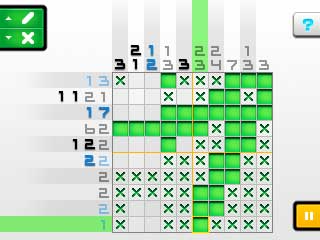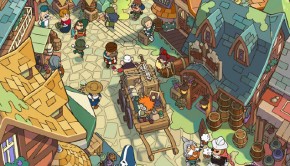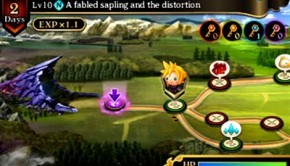Picross e: Brain Training
I’ve never played a bad electronic implementation of Picross. Mario’s Picross, Illust Logic, Picross DS; they’ve all eaten up many hours of my life and caused more sleepless nights than any other genre of game. But Picross e, Jupiter’s latest eShop offering, is a cut above, and it’s worth exploring why.
But first, I have to explain why Picross is the finest genre of logic-based number puzzle there is. (If you’ve played it before, feel free to skip ahead a couple paragraphs.) Perhaps you might remember the brief national craze for Sudoku, the number puzzle wherein one arranges the numerals 1-9 on several square-shaped grids according to formal rules. Those of us who had played Picross found Sudoku’s popularity wholly baffling, when Picross was right there as the obviously superior puzzle. Although both puzzles require the solver to employ a logical process of elimination to fill in a steadily narrowing set of possibilities across a grid, at the end of Sudoku you have a bunch of numbers, and at the end of Picross you have a neat little picture.
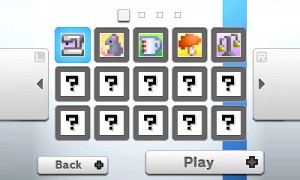 This isn’t a minor point. Sudoku became popular in part because creating the bare-bones puzzles was easy and cheap to automate with a computer program. The pixel art of a Picross puzzle, in contrast, makes each one feel handcrafted. Electronic versions of Picross are especially good at providing the player with strong visual payoff. Picross DS converted monochromatic solved puzzles to animated color pixel art, and Illust Logic included a few special puzzles that had you creating huge art pieces one section at a time.
This isn’t a minor point. Sudoku became popular in part because creating the bare-bones puzzles was easy and cheap to automate with a computer program. The pixel art of a Picross puzzle, in contrast, makes each one feel handcrafted. Electronic versions of Picross are especially good at providing the player with strong visual payoff. Picross DS converted monochromatic solved puzzles to animated color pixel art, and Illust Logic included a few special puzzles that had you creating huge art pieces one section at a time.
Picross also has the advantage of scalability. Sudoku is hampered by mandatory 9×9 grids, but Picross puzzle grids can be any size. This makes it easy to show newcomers the ropes with smaller 5×5 puzzles before working their way up to the larger challenges. (One of Picross e’s few failings, admittedly, is that it doesn’t have puzzles larger than 15×15 for the hardcore Picross devotee.)
What Picross e does right—more right than any other version of the game—is its ingenious help feature. Lots of Picross games offer an explicit “hint” feature for novices, which usually fills in one row and one column as a starting point. I make a point of pride of never using it. But Picross e’s unique help feature avoids explicit answers, instead conveniently offering players of any skill level a great way to develop their game further.
Play Picross for even a little while and you’ll start to recognize certain logic patterns that shape the way you think about the puzzles. These patterns form a kind of mental shorthand when it comes to seeing solutions. For instance, if you’re working a 10×10 puzzle and see a lone “6” in a row or column, you automatically know that the middle two spaces can be safely filled in. (After all, no matter where that 6-space segment falls in the line, the middle two spaces will always be filled in.) Eventually, you don’t need to puzzle out the entire chain of logic every time a common clue appears-you just see the clue and know what it means.
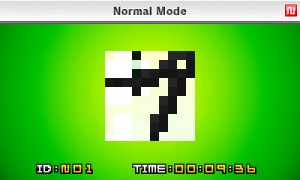 Some of these logic patterns are harder to tease out than others, though, and that’s where Picross e’s help system shines. With the help system activated, the numbers dictating how many filled spaces each row or column contains can be either black or blue. Blue numbers tell the player that “something can be done here.” The ingeniousness of this help system is that it doesn’t tell the player what can be done or how to find it-just that there’s something worth examining more closely. Assuming that you haven’t made any glaring mistakes, the blue numbers are never wrong. It’s just a matter of figuring out what they’re trying to tell you.
Some of these logic patterns are harder to tease out than others, though, and that’s where Picross e’s help system shines. With the help system activated, the numbers dictating how many filled spaces each row or column contains can be either black or blue. Blue numbers tell the player that “something can be done here.” The ingeniousness of this help system is that it doesn’t tell the player what can be done or how to find it-just that there’s something worth examining more closely. Assuming that you haven’t made any glaring mistakes, the blue numbers are never wrong. It’s just a matter of figuring out what they’re trying to tell you.
The result is that Picross e’s help system trains you to discover and spot new logic patterns, ones that may not have occurred to you even if you’ve spent dozens of hours playing Picross already. When the time comes to take on the most challenging puzzles where every hint feature is disabled, it’s only the mastery that you’ve learned from the game’s gentle nudging that lets you make it through “on your own strength”-as the game’s strangely localized script has it.
Every digital Picross game is worth playing. I wholeheartedly and unreservedly would recommend any of them. But now, when the question of which to play first comes up, Picross e is the clear answer, the rare puzzle game that teaches its own precepts with a perfect subtlety. At a time when other Nintendo titles are fumbling the ball when it comes to naturally and organically teaching the player the rules of the game, it’s good to see there’s one game out there serving as a master class in how to do it right.

